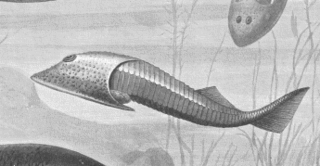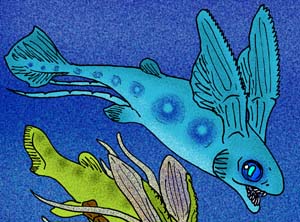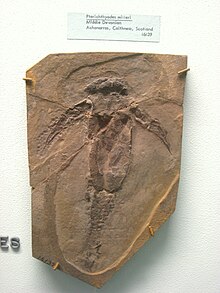
Chondrichthyes is a class that contains the cartilaginous fishes that have skeletons primarily composed of cartilage. They can be contrasted with the Osteichthyes or bony fishes, which have skeletons primarily composed of bone tissue. Chondrichthyes are jawed vertebrates with paired fins, paired nares, scales, and a heart with its chambers in series. Extant chondrichthyes range in size from the 10 cm finless sleeper ray to the 10 m whale shark.

Gnathostomata are the jawed vertebrates. Gnathostome diversity comprises roughly 60,000 species, which accounts for 99% of all living vertebrates, including humans. In addition to opposing jaws, living gnathostomes have true teeth, paired appendages, the elastomeric protein of elastin, and a horizontal semicircular canal of the inner ear, along with physiological and cellular anatomical characters such as the myelin sheaths of neurons, and an adaptive immune system that has the discrete lymphoid organs of spleen and thymus, and uses V(D)J recombination to create antigen recognition sites, rather than using genetic recombination in the variable lymphocyte receptor gene.

Cephalaspidomorphs are a group of jawless fishes named for Cephalaspis of the osteostracans. Most biologists regard this taxon as extinct, but the name is sometimes used in the classification of lampreys, because lampreys were once thought to be related to cephalaspids. If lampreys are included, they would extend the known range of the group from the Silurian and Devonian periods to the present day. They are the closest relatives of jawed fishes, who emerged from within them and they would survive if the jawed fish are included.

Acanthodii or acanthodians is an extinct class of gnathostomes, typically considered a paraphyletic group. They are currently considered to represent a grade of various fish lineages leading up to the extant Chondrichthyes, which includes living sharks, rays, and chimaeras. Acanthodians possess a mosaic of features shared with both osteichthyans and chondrichthyans. In general body shape, they were similar to modern sharks, but their epidermis was covered with tiny rhomboid platelets like the scales of holosteians. A lower Silurian species, Fanjingshania renovata, attributed to Climatiiformes is the oldest chondrichthyan with known anatomical features.

Placodermi is a class of armoured prehistoric fish, known from fossils, which lived from the Silurian to the end of the Devonian period. Their head and thorax were covered by articulated armoured plates and the rest of the body was scaled or naked, depending on the species. Placoderms were among the first jawed fish; their jaws likely evolved from the first of their gill arches.

Dunkleosteus is an extinct genus of large armored, jawed fishes that existed during the Late Devonian period, about 382–358 million years ago. It consists of ten species, some of which are among the largest placoderms to have ever lived: D. terrelli, D. belgicus, D. denisoni, D. marsaisi, D. magnificus, D. missouriensis, D. newberryi, D. amblyodoratus, and D. raveri. The largest and most well known species is D. terrelli, which grew up to 8.79 m (28.8 ft) long and 4 t in weight. Dunkleosteus could quickly open and close its jaw, like modern-day suction feeders, and had a bite force of 4,414 N at the tip and 5,363 N at the blade edge. Numerous fossils of the various species have been found in North America, Poland, Belgium, and Morocco.

Bothriolepis was a widespread, abundant and diverse genus of antiarch placoderms that lived during the Middle to Late Devonian period of the Paleozoic Era. Historically, Bothriolepis resided in an array of paleo-environments spread across every paleocontinent, including near shore marine and freshwater settings. Most species of Bothriolepis were characterized as relatively small, benthic, freshwater detritivores, averaging around 30 centimetres (12 in) in length. However, the largest species, B. rex, had an estimated bodylength of 170 centimetres (67 in). Although expansive with over 60 species found worldwide, comparatively Bothriolepis is not unusually more diverse than most modern bottom dwelling species around today.

Groenlandaspis is an extinct genus of arthrodire from the Late Devonian. Fossils of the different species are found in late Devonian strata in all continents except eastern Asia. The generic name commemorates the fact that the first specimens of the type species were found in Greenland.

Rhenanida is an order of scaly placoderms. Unlike most other placoderms, the rhenanids' armor was made up of a mosaic of unfused scales and tubercles. The patterns and components of this "mosaic" correspond to the plates of armor in other, more advanced placoderms, suggesting that the ancestral placoderm had armor made of unfused components, as well.

Gemuendina stuertzi is a placoderm of the order Rhenanida, of the seas of Early Devonian Germany. In life, Gemuendina resembled a scaly ray with an upturned head, or a large-finned stargazer. G. stuertzi is often invoked as an example of convergent evolution- with its flat body and huge, wing-like pectoral fins it has a strong, albeit superficial similarity to rays. Unlike rays, however, both Gemuendina`s eyes and nostrils were placed atop the head, facing upward. Furthermore, G. stuertzi's upturned mouth would have enabled it to suction prey that swam overhead, rather than swallow sediment or suction prey out of the substrate like modern rays.

Antiarchi is an order of heavily armored placoderms. The antiarchs form the second-most successful group of placoderms after the arthrodires in terms of numbers of species and range of environments. The order's name was coined by Edward Drinker Cope, who, when examining some fossils that he thought were armored tunicates related to Chelysoma, mistakenly thought that the orbital fenestra was the opening for the mouth, or oral siphon, and that the opening for the anal siphon was on the other side of the body, as opposed to having both oral and anal siphons together at one end.

Acanthothoraci is an extinct group of chimaera-like placoderms who were closely related to the rhenanid placoderms. Superficially, the acanthoracids resembled scaly chimaeras, or (relatively) heavily armored ptyctodonts. They were distinguished from chimaeras by the presence of large scales and plates, a pair of large spines that emanate from their chests, tooth-like beak plates, and the typical bone-enhanced placoderm eyeball. They were distinguished from other placoderms due to differences in the anatomy of their skulls, and due to patterns on the skull plates and thoracic plates that are unique to this order.

Lunaspis is an extinct genus of armor-plated petalichthyid placoderm fish that lived in shallow marine environments of the Early Devonian period, from approximately 409.1 to 402.5 million year ago. Fossils have been found in Germany, China and Australia. There are three different identified species of within the genus Lunaspis: L. broilii, L. heroldi, and L. prumiensis.

Phyllolepis is the type genus of Phyllolepida, an extinct taxon of arthrodire placoderm fish from the middle to late Devonian. The species of Phyllolepis, themselves, are restricted to the Famennian-aged freshwater strata of the Late Devonian, around 360 million years ago. Fossils of this genus have been found primarily in Europe and North America. The end of the Devonian saw them disappear in a mass extinction.

Iniopterygiformes is an extinct order of chimaera-like cartilaginous fish that lived from the Devonian to Carboniferous periods. Fossils of them have been found in Montana, Indiana, Illinois, and Nebraska. The Iniopterygians are characterized by large pectoral fins, wing-like projections on their backs, mounted high on the body and denticulated bony plates on the head and jaws. Iniopterygian sharks were small, and their average length was about 18 inches (46 cm). The elongated pectoral fins had denticles along the leading edge which may have had a role in mating. They are thought to have been able to move their pectorals in a vertical plane, ”flying” through the water much like modern-day flying fish.

Guiyu oneiros is the earliest articulated bony fish discovered. The generic name Guiyu is a transliteration of the Mandarin 鬼魚 guǐyú "ghost fish" and the specific name oneiros is from Greek ὄνειρος "dream". Fossils of Guiyu have been found in what is now Qujing, Yunnan, China, in a late Silurian marine strata, about 425 million years old. Guiyu remains have been found articulated, missing only the caudal fin. The living fish is estimated to have been around 30 cm long.

Fins are distinctive anatomical features composed of bony spines or rays protruding from the body of a fish. They are covered with skin and joined together either in a webbed fashion, as seen in most bony fish, or similar to a flipper, as seen in sharks. Apart from the tail or caudal fin, fish fins have no direct connection with the spine and are supported only by muscles. Their principal function is to help the fish swim.

The evolution of fish began about 530 million years ago during the Cambrian explosion. It was during this time that the early chordates developed the skull and the vertebral column, leading to the first craniates and vertebrates. The first fish lineages belong to the Agnatha, or jawless fish. Early examples include Haikouichthys. During the late Cambrian, eel-like jawless fish called the conodonts, and small mostly armoured fish known as ostracoderms, first appeared. Most jawless fish are now extinct; but the extant lampreys may approximate ancient pre-jawed fish. Lampreys belong to the Cyclostomata, which includes the extant hagfish, and this group may have split early on from other agnathans.
Microbrachius is an extinct genus of tiny, advanced antiarch placoderms closely related to the bothriolepids. Complete articulated specimens show that the armored section of the body had an average length of 2-4 cm. Species of Microbrachius are characterized by having large heads with short thoracic armor. Specimens of Microbrachius have been found in Scotland, Belarus, Estonia, and China. Specimens range in age from the Lower Devonian Late Emsian Stage to the Middle Devonian Upper Givetian Stage.

Asterolepis is an extinct genus of antiarch placoderms from the Devonian of North and South America and Europe. They were heavily armored flat-headed benthic detritivores with distinctive jointed limb-like pectoral fins and hollow spine. The armor plate gives the Asterolepis a box-like shape. Its pectoral fins are also armored but the caudal and dorsal fin are not. The first fossils were named by M. Eichwald in 1840 after noticing star-like markings on the fossils.






















